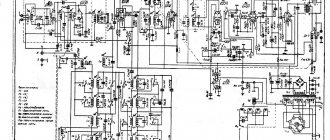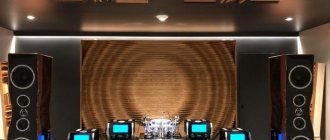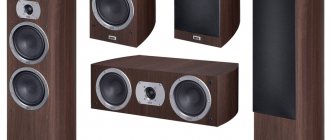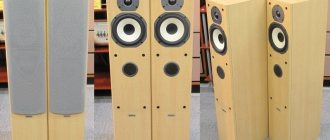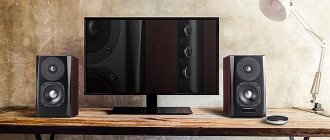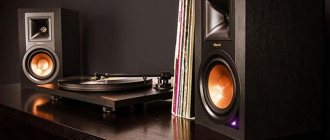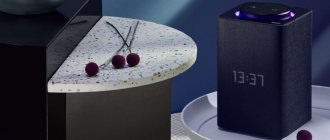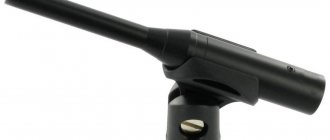Music lovers, gamers and simply lovers of pure sound know how difficult it is to choose the right acoustics for your home or office. Such equipment must have an affordable price and meet the user’s requirements. And the list of requests is considerable: crystal sound at all volumes, good power to “pump up” neighbors, an abundance of ports for synchronizing with devices, etc.
An excellent choice when purchasing computer audio equipment would be a mix of a subwoofer and speakers. Such models are of type 2.1, that is, 2 satellites are combined with a subwoofer. How to choose the right set and what to focus on is discussed further in the article.
SVEN MS-90 – handsome in black gloss
Laconically designed acoustics are ideal for all fans of high-quality sound. The model includes 2 speakers and a subwoofer. The combination of these devices delivers deep, rich bass without sounding hoarse or distorting. Using mechanical switches on the front panel of the sub, you can adjust the frequency and volume to suit your personal preferences.
The set is compatible with multimedia, smartphones, and PCs. The connection is made using a Mini Jack 3.5 cable, and the settings themselves take a record time. The acoustic power is 10 W, which is quite enough for watching movies in “cinema” mode, as well as listening to music at home.
The advantages of this model are noteworthy:
- Light weight. The weight of the entire set is 1.28 kg, which means transportation and moving around the apartment will be problem-free.
- Presence of magnetic shielding. The technology will protect against unpleasant interference.
- Design . The subwoofer body is made of black MDF, which in combination with mirrored glossy plastic looks especially impressive. There is an on-mode indicator light on the front panel.
One of the disadvantages is that the acoustics do not provide Wi-Fi or Bluetooth connections. So you can immediately forget about adjusting the volume or other manipulations at a distance.
EDIFIER MP300 Plus – a compact device for a computer
This “baby” attracts attention at first sight: non-standard design of the case, fashionable combination of colors (there are options in black, yellow, red and even pink), dimensions. Everything here is chosen with taste and is designed to satisfy even the most sophisticated requirements. The acoustics include two spherical speakers and a tube-shaped subwoofer. Thanks to this design, the sub is comfortable to hold in your hand, taking it with you for a walk or relaxing with friends.
The portable MP300 Plus produces clear sound across all ranges, with notes not distorted even at very loud volumes. Such mini-acoustics are ideal for listening to music from a smartphone or laptop, connecting to them using a cable. Thanks to its 22 W power, the device can easily fill a large apartment with sound.
pros
The sound is sufficient for one room, the lows are not as dense as we would like (written down as a minus), but overall the sound is quite high quality
The remote control has a good coverage area and “hits” the speakers much better than the same Thonet & Vander Dass BT.
The design of the speakers is quite stylish - black and red contrast very well.
There are no time limits when switching to Bleutooth (as, again, with Thonet & Vander) - the speakers will wait as long as you like until you connect from your phone or laptop.
F&D T-200X – cool multimedia kit
If you want to periodically turn your home into a cinema, the F&D T-200X acoustics will be an ideal purchase. This versatile model has a power of 70 W and reproduces sounds in the range of up to 20 thousand Hz. The 2.1 system is complemented by a control panel for easy manipulation of sound and other settings.
The speakers are covered in a plastic case and have two speakers. In unison with the subwoofer they produce a clear and contrasting sound. The sub is equipped with mechanical frequency and bass adjustment. These switches are located on the back of the case.
There are countless advantages here:
- The speakers can be hung on the wall or placed on stands, even in close proximity to. For a particularly extravagant interior, it is possible to connect them together by making a soundbar under the screen.
- The sub deserves special attention. The front panel of this device glows in the dark, and the colors change. Using the remote control, you can configure both single-color lighting and real light music.
- There is a USB port on the side of the subwoofer, which allows you to enjoy your favorite hits recorded on a flash drive. The device is also equipped with FM and Bluetooth.
Everything seems to be perfect, and there’s nothing to complain about. True, the price is a little high, and karaoke is not enough for complete happiness.
Ginzzu GM-406
- Total power: 40 W / subwoofer 20 W, speakers 10 W
- Frequency range: 40 to 20,000 Hz
- Speakers: single-way
- Connections and connectors: Bluetooth, USB-A, card reader, RCA
- Remote: wireless
- Housing material: subwoofer - MDF, speakers - plastic
- Subwoofer size: 17 × 26.6 × 23.8 cm
- Speaker size: 9 × 15.3 × 8.7 cm
- Total weight: 3.2 kg
- Power: 220-240 V, 50 Hz
The Ginzzu GM-406 audio system attracts attention with its gamer-like appearance, a large set of connection interfaces and an extremely low price tag, for which you can close your eyes to a lot. But believe me, you won’t have to endure mistakes here. The quality of the speakers exceeds expectations. The 10-watt satellites operate completely rattle-free, even despite the budget plastic housing. Provide amazingly clear sound when connected via Bluetooth and shocking silence when idle. Although it often happens that more expensive models hiss in the absence of an audio stream from the source. The 20-watt subwoofer pumps out the lows well. And within the framework of today’s rating, Ginzzu GM-406 is the cheapest copy of computer acoustics with a wireless remote control. The stereo system confidently earns every ruble of its price. For the amateur level, these speakers are great. The timbre block allows you to adjust the sound optimally. The volume is easily enough for several rooms. The built-in radio picks up dozens of stations. A really cool choice for music and movies. The only significant drawback is the remote control. Through it, the control is somehow inhibited.
F&D A180X – original model at an affordable price
This speaker system evokes a whole flurry of emotions, and all thanks to the non-trivial decor of the case. The speakers and subwoofer are designed in a futuristic style, where the black color is stunningly combined with huge diamond-shaped curves. The materials used to make this masterpiece are plastic and MDF.
The kit is small in size and suitable for installation on a table. Synchronizes with any devices (for example, a music center) via cable, Bluetooth or USB connector. The subwoofer is turned on using buttons on the body, and settings and control are carried out via the remote control.
This copy has the following advantages:
- The front panel of the subwoofer is decorated with an LED display, which displays the sound level, bass and other parameters.
- The built-in FM radio stores up to 100 waves, quickly switching between channels without interference or signal failures.
- The sub produces a fairly strong sound with flexible, rich bass. These notes can be clearly heard in any music, which will especially appeal to lovers of rock or other “heavy” melodies.
The acoustics are one of the best in its price segment, although they are not without their drawbacks. For example, there is no Wi-Fi here, and the power of the subwoofer is slightly too low, as for its dimensions (26.6 x 17.3 x 27.85 cm) - 14 W.
You might be interested in: Active and passive speakers - what is the difference: 3 selection criteria
Logitech Z533
When we talk about the "best" in any peripheral category, Logitech can't be missing, and in this case we're highlighting its Z533 system, which includes two satellites and a dedicated passive subwoofer to deliver a total of 60W RMS power (120W peak). ). according to the manufacturer). It has a control console with analog mute and volume controls, as well as jacks for connecting headphones to the speaker system itself, allowing us to use them without disconnecting the speakers from the back of the PC.
MICROLAB M-880 – a design classic
Inexpensive acoustics are suitable for both music lovers and gamers. A set of speakers and a subwoofer produces crystal clear sound, regardless of the volume or the connected device. The total power of the set is 59 W, with 29 W falling on the sub. All this combined with 5.25-inch speakers guarantees sound without the slightest noise or interference.
The equipment is equipped with long cords, which allows you to place acoustic elements at a distance from each other, placing them compactly around the room for an “enveloping” sound. Satellites are suitable for installation near Smart-TV, since they have magnetic shielding in their arsenal.
Here are the advantages of Microlab M-880:
- Bass and frequency controls are located on the front panel for ease of use. There is also a headphone jack and a mechanical volume switch with blue backlight.
- The strict appearance of the acoustics with clear lines and a contrasting combination of metallic/black will easily fit into the interior of any room, giving it solidity.
- Wide range of applications. The model is used with mp3 players, phones, PCs, etc.
The acoustics do not offer any special capabilities. There is no remote control or remote control, which is a disadvantage of the model.
Minuses
Don't expect any miracles from a subwoofer in a “computer” case. At volumes above average, an unpleasant “fart” already appears. Listening to rock/metal/alternative music on them is not very pleasant (pop, deep, drum and bass are the norm)
After turning off the speakers from the network (out of the socket), synchronization with the laptop gets lost (we assume that the problem is only with our specific laptop). You have to constantly turn it off and on - after that the adapter instantly finds the speakers.
There are not very reliable, thin wires going to the satellites - be careful when transporting them. This model has only bass adjustments - no mids or highs.
Buy yourself SVEN MS-304
MICROLAB M-105R – another budget device in the rating
The MICROLAB M-105R model is the best answer to the question: “Which 2.1 speaker system should I buy if I have minimal money, but really want to listen to music in high-quality sound?” Here, the standard set of subwoofer, speakers and instructions is complemented by a control panel that helps you adjust the sound and make basic settings.
In the review of this acoustics, the main emphasis should be on the subwoofer. It is equipped with all possible connectors: SD, USB, 2RCA. A strip of sockets is located on the front panel, providing quick and easy access to the ports.
The equipment will show itself in all its glory on game consoles and PCs.
Users choose this instance due to:
- subwoofer with front bass reverter for more powerful bass sound;
- simple design without extraordinary elements and unnecessary decor;
- built-in amplifier that operates at RMS power (produces maximum sound without damaging the subwoofer housing);
- The entire set is made of MDF, no plastic.
The “honey” collection also has a built-in FM radio and good, clear sound, without distortion.
The only downside is the lack of wireless synchronization, and even then, at this price, a model without Wi-Fi will easily take root.
Why doesn't my laptop see the speakers?
You can address this and other questions on computer electronics to the special section of Vamber - https://vamber.ru/question-category/kompyuteryi-elektronika-it/. By the way, by answering users’ questions there, you earn money yourself. Yes, yes, that notorious passive income on the Internet, but only with your mind. If your laptop cannot be seen by any device at all, then check whether Bluetooth is allowed on Windows 10. On the laptop (Windows 10), call the context menu of the bluetooth icon (right-click) and select “Add device”. In the window that opens, scroll down to the “Other Bluetooth settings” link
In the new window, check the boxes
In our case, only the Acer Extensa EX2519 laptop did not see the speakers (phones were connected). The only thing that helped was reinstalling the drivers for the bluetooth adapter. So, if Thonet & Vander do not see your laptop, but still cling to the phone, reinstall the driver (the model can be viewed in the device manager)
MICROLAB M-100 – a good addition to your PC
This 2.1 type acoustics is made in a minimalist design and strict black color. This set will harmonize with any room decoration, becoming a full-fledged part of the entire interior composition.
The total output power of the model is 10 W, where 2.5 W is taken by the satellites, and the rest goes to the subwoofer. Despite these parameters, the trio produces deep and clear sound with voluminous bass. This sound is especially typical for gamer battles, but will also not leave fans of electronic music and cinema indifferent.
The most compelling arguments in favor of purchasing the MICROLAB M-100 are:
- The cable input and output ports are conveniently located - not behind the subwoofer, like other acoustics, but on the back side of one of the speakers. This allows you to move the sub around the apartment without feeling “tied” to the device.
- The speakers of the speakers have an aluminum grille, which not only acts as part of the decor, but also performs a protective function from various types of damage.
- The subwoofer is mounted on 4 cone-shaped legs for greater stability.
- The system is suitable for connection to any source with a 3.5 mm interface (for example, home theater).
The downside is that there is no radio or Bluetooth.
“Crystal Sound”: Comparative testing of 2.1 acoustics
Edifier C2XD and Sven MS-3000 February 2014
|
Last month we looked at inexpensive 2.1 sets, six months ago we compared two multimedia 2.1 sets with external amplifier units, the price of which was in the range of $110-130, and today we will rise to the next price level - $130-150. The configuration of the participants in the February “duel” is the same - 2.1 systems with an external amplifier, produced by Edifier and Sven.
Both sets are supplied in colorfully decorated boxes made of high-quality cardboard.
We start with the characteristics of both participants.
| Edifier C2XD | Sven MS-3000 | |
| Dimensions (H×W×D), mm: subwoofer satellites amplifier | 243×232×288 194×90×143 256×79×218 | 261×260×266 201×119×125 200×70×220 |
| Weight (net/gross), kg | 7,75 / 9,10 | 6,98 / 7,70 |
| Subwoofer woofer: | ||
| diffuser diameter, cm | 14,5 | 14,5 |
| diffuser material | paper | paper |
| suspension material | rubber | polymer |
| orientation | front | front |
| Satellite midrange speaker: | ||
| diffuser diameter, cm | 6,5 | 6,7 |
| diffuser material | paper | paper |
| suspension material | polymer | rubber |
| Satellite tweeter: | ||
| diffuser diameter, cm | 1,9 | 2,5 |
| diffuser material | textile | textile |
| Acoustic design : satellite subwoofer | FI, rear port ZY | ZYA FI, rear port |
| Speaker housing material | MDF | MDF |
| Availability and type of remote control | yes, wireless | yes, wireless |
| Output power, W (declared, RMS) | 53 (35 + 2×9) | 80 (40 + 2×20) |
| Number of inputs for signal sources | 2×RCA two mini-jack 3.5 mm optical | two 2×RCA one mini-jack 3.5 mm |
| Peculiarities | Four inputs (two of them combined), headphone output | Three inputs, headphone output, USB port, SD slot, FM radio, clock |
| Link to description | edifier.ru | sven.fi/ru |
| Retail price in Moscow | $138(), T-10533114 | $143(), T-10474393 |
| — measured in our laboratory, taking into account protruding parts of the structure; values may differ from those shown on manufacturers' websites. — measured in our laboratory; values may differ from those shown on manufacturers' websites. | ||
Testing was carried out in accordance with our loudspeaker testing methodology.
Edifier C2XD
Functionality
The set is made in a futuristic style, which the company adheres to in many 2.1 acoustic models. The subwoofer is still closer to a classic cube; only the volumetric surface of the grill, crossed out with a silver stripe, stands out. The satellites are more unusual: the grill is slightly rounded in the horizontal section, has a reverse vertical slope, and the tweeter is located in a protruding silver “flashlight”. And the shape of the amplifier is completely non-trivial: from the front it resembles an hourglass, the “waist” of which is closed by a round aluminum-look handle.
All components are painted black, no other colors are reported.
The grills on all three speakers are non-removable, or rather, they can be removed without much effort, but the view that opens up is not intended to please the eye. The grills are made of soft fabric on a plastic grille and are attached with protrusions to the holes on the front surfaces of the housings (through satellites, blind in the subwoofer). The feet are round rubber stickers about 2 mm thick for the subwoofer and no more than a millimeter for the satellites.
The speakers are connected using non-removable cables (for satellites 2.3 m long, for a subwoofer exactly 2 meters), one end of which is soldered inside the speaker, and the other is equipped with an RCA connector. The cables are thin and rigid, and the places where they exit from the rear walls of the speakers are not protected from chafing.
The subwoofer is equipped with a woofer with a diffuser diameter of 14.5 cm, impedance 4 Ohms, power not specified. The body is made of MDF, the thickness of the front panel is 12 mm, we couldn’t take measurements for the rest, but it looks like they are no thinner. There is a certain amount of synthetic padding inside the case, and the junction of the speaker and the case is equipped with a seal. The acoustic design is a bass reflex, the port is located on the rear wall.
The satellite housings are closed boxes; thinner MDF is used for them: slightly less than 9 mm. There is a groove on the back wall for hanging. There is also a small piece of synthetic padding inside, and the junction of the midrange speaker with the body does not have a seal. The midrange speaker winding resistance is 4 Ohms, the power is also not indicated, the diffuser diameter is 6.5 cm.
The tweeter has a fabric cone with a diameter of ¾ inches and a cone shape with a small central dome. It is entirely located in a protruding plastic nozzle at the top of the satellite and is connected through a 2.2 µF capacitor. The tweeter dome is protected from mechanical damage by a jumper, in the center of which there is a horn cap, which is an aperture body, i.e. a reflector that expands the HF radiation pattern. We have already seen such solutions more than once in Edifier speakers, but they do not always lead to the expected result: the sound still turns out to be directional, which in this case was confirmed during listening.
The front panel of the amplifier is divided into two parts by a single control; the lower one is matte, and the upper one is glossy and translucent, indicators are visible through it: red two-digit seven-segment, displaying the set volume levels (from 0 to 50) and timbre (from −9 to +9 for low frequencies and from −7 to +7 for high frequencies), to the left and right of which are green LEDs indicating the selected input and the current tone control function (bass or treble). Below the indicators is an IR remote control sensor.
Everything is very similar to the Edifier HCS2330 amplifier, and even the behavior of the indicator when switching to Standby mode is similar to what we saw in the HCS2330 for Mute: the numbers quickly run from the current volume level to zero, then replaced by two horizontal lines, and when returning to working the opposite mode: the numbers run from zero to the previously set value.
At the top of the decorative cylinder surrounding the regulator are three buttons. The central one controls the power, the left one sets the adjustment function - volume, treble or bass tone, and the right one can select the input. The perimeter regulator has a red backlight, which turns off in Standby mode.
On the back wall of the amplifier there are concentrated connectors: input (analog 2×RCA and mini-jack, as well as optical), three output RCA for connecting speakers (with color markings corresponding to the colors of the connectors on the speaker cables). At the very bottom there is a mechanical switch and a power cable outlet.
There are two more 3.5 mm connectors on the right side wall, closer to the front panel. Headphones are connected to one of them (the speakers are turned off), and various sound sources can be quickly connected to the second. But both mini-jack inputs are not switched using the controls; they are considered a single AUX input; simply, when the cable is connected to the connector on the side wall, the second such connector is disabled.
To get to the inside of the amplifier, you have to tinker: in addition to the screws, the parts of the case are connected by numerous latches. For meticulous readers, we have supplemented the description with photo illustrations.
The power amplifier is analog, on the TDA7375 chip with four amplification channels, two of which are loaded to the satellites, and two more are bridged to the subwoofer. Since such amplifiers have low efficiency, we had to install the microcircuit on a rather large radiator, the fins of which are oriented vertically for better convection (in the photo the lower part of the amplifier is on the right).
The radiator is quite efficient: in the absence of a signal, it heats up by only 10–11 degrees. However, when working for a long time at high volume, the almost complete lack of ventilation can begin to take its toll: there are several dozen small holes on the bottom edge of the case, but the legs of the amplifier are only a couple of millimeters high, so air access through them will be limited. There are only a few tiny slots in the grooves of the side walls for the heated air to escape, and the ribs at the rear of the upper surface of the body are purely decorative, there are no slots between them. Unfortunately, in our conditions there is no way to run the set for hours at a volume close to maximum, and we were not able to confirm or refute doubts in practice.
The input selection is made by the TDA7303 processor, which also processes the signals: adjusting the volume (with loudness compensation) and timbre. Its functions such as adjusting stereo balance and front-rear balance are not used. The processor is controlled via the I2C bus from the STM8L152C6T6 controller located on the control panel board.
The amplifier claims an intelligent gain control function patented by Edifier called EIDC. Let's briefly recap what is available on the official website: the level of signals from possible sources can be very different, so if the signal is too large, the power amplifier may be overloaded, which can at least increase the level of distortion , or vice versa - if the signal is too small, the signal-to-noise ratio will increase. Obviously, optimization of the signal level is precisely done in the TDA7303, which allows you to set the gain separately for each of the three switched sources.
Frequency separation of channels for satellites and subwoofer is carried out by filters on N5532 operational amplifiers. The DIR9001 chip is responsible for working with the digital input, and the 4334KSZ DAC converts the signal from it into analog form.
The power supply is switching, very similar to the one we saw in the Edifier HCS2330, it produces the same 18 V in the absence of a signal and whistles slightly in the same way, but not only in Mute mode, but in any state. True, the power supply has lost its copper foil screen - there is only a protective insulating shell, although there is a photograph with the screen on the manufacturer’s website. An additional capacitor with a capacity of 2200 μF is installed on the amplifier board in the power circuit.
The remote control is also similar to the one included in the HCS2330 kit, only an optical input selection button has been added. The membrane buttons are not very convenient, but the sensitivity of the sensor is still good. The remote control is powered by a CR2025 battery.
The kit also contains two one and a half meter cables - optical and 2×RCA - mini-jack, as well as instructions, including Russian.
The set of pros and cons is the same as that of the HCS2330.
Advantages:
- background and noise levels are low, noticeable only at close to maximum volume levels and tone controls, and even then in close proximity to the speakers;
- absence of parasitic overtones during adjustments and switching.
Flaws:
- to adjust the volume and bass/treble tone on the amplifier panel there is one regulator and one button (which selects what exactly is being adjusted), which is not very convenient; There are separate adjustments on the remote control;
- light click when turned on mechanically with a toggle switch;
- To connect the speakers to the amplifier, a rather thin cable is used, which is difficult to replace.
The thermal conditions of the amplifier during long-term operation at high volume raised doubts. In addition, the length of the wires connecting the amplifier to the speakers may not be sufficient, and although it is possible to extend them, it is not as easy to do as in the Sven MS-3000 kit.
Sound
The sound of the Edifier C2XD should be described as good. Among the advantages of this acoustics, we should highlight the good sound of the satellites in the mid-frequency region, as well as the balanced sound of the satellites and subwoofer.
The vast majority of 2.1 acoustic models of a similar form factor have a very peculiar sound of satellites: as a rule, the mid frequencies of the speakers have a noticeable timbre distortion and a pronounced accent of some frequency segment. The satellites from the C2XD set do not have the described disadvantages. Of course, their sound is specific due to the use of a small-sized woofer, but at least the upper midrange sounds full and relatively smooth.
Among the shortcomings, it is worth noting the dirty high frequencies. Distortion at the high frequencies gives the sound of satellites a characteristic color. For better intelligibility, you have to add two or three levels of high frequencies using the existing equalizer. This inevitably leads to an increase in the described feature. In addition, it is worth mentioning the sound direction of the satellites; the optimal listening point is on the axis of the tweeters. If you are higher, there is a decrease in saturation in the sound in the high frequency range.
The sound of the subwoofer is remarkable in that it has no spurious overtones or high-frequency components. Even at high volume levels, there are no resonances or wheezing in the sound. With the satellites used, the subwoofer sounds quite balanced, moderately saturating the low-frequency range and not protruding the upper register.
Combined frequency response graphs of satellite and subwoofer
Satellite frequency response graphs in different equalizer modes
Judging by our measurements, the frequency response unevenness of the satellite is ±6 dB in the range of 150 Hz – 20 kHz. The subwoofer's woofer fully reproduces frequencies starting from 60 Hz and covers a range of up to 180 Hz, while the lower range is expanded by a bass reflex. Thus, the frequency ranges of the subwoofer and satellites can be considered consistent.
Treble adjustment is available over a range of ±12 dB at 10 kHz.
| Average price according to price.ru |
| $138() |
| Average price according to Yandex.Market |
| T-10533114 |
| Edifier C2XD offers according to Yandex.Market |
| L-10533114-10 |
Sven MS-3000
Functionality
The kit's equipment is more than decent: in addition to three inputs for external signal sources and remote control, there is:
- player of MP3 files that can be recorded on two types of media - USB flash or SD card,
- FM tuner,
- watch,
- headphone output.
Perhaps the only thing missing “for complete happiness” is a digital input: the available inputs are designed only for analog signals.
But when looking at the amplifier (from the front, from the side, from the back and even from below), a feeling of deja vu arises: we have already seen this somewhere... And indeed: if you strain a little, you remember Thonet & Vander Ratsel, well, just a twin brother! To be precise, the brother is still the younger: Ratsel did not have ports for a flash drive and SD card, and accordingly, the controls on the front panel were smaller and the indicator was simpler. But we can hardly talk about some kind of borrowing; rather, these are the fruits of globalization: as car manufacturers put it, these models are made on a common platform. True, Thonet&Vander, unlike Sven, did not forget to put their own logo on the front panel of the amplifier.
Therefore, we hastened to open the amplifier case to try to find differences, at least inside. If we talk about the power supply, then there are no differences, neither external nor in output parameters - a switching power supply unit that produces 22 V in the absence of a signal, without any screens, and in the same way it emits a slight whistle (but quieter than a power supply unit in Edifier amplifier).
The power amplifier board is already a little different, but the differences are mainly cosmetic: some components are arranged a little differently, some things have been added (for example, a connector for an FM antenna, for which Ratsel also had a place, but the connector itself was not wired), some what is missing.
But the circuitry is similar: signal processing, including volume/tone controls and input switching, is carried out by the PT2313L audio processor; like the T&V, some of its features, including stereo balance adjustment, are not used. The Loudness loudness compensation function is enabled, taking into account the peculiarities of sound perception by the human ear at low volume levels; it is possible that it was also used in Ratsel, it’s just that this fact was not emphasized in the description and there was no button to disable this mode. There are also two operational amplifier chips: a quad TL084 and a dual N5532, which is used to make a headphone amplifier. But the power supply for low-current circuits is organized on the basis of the TPS54231 DC-DC converter; Ratsel had analog stabilizers.
As in Ratsel, a class D amplifier is used on two two-channel TPA3123D2 microcircuits: two channels of one microcircuit in Single Ended mode work on satellites, the second microcircuit in Bridge mode is loaded on a subwoofer. Both microcircuits have a common aluminum radiator of a small area, but the part of the radiator adjacent to the microcircuits heats up less in the absence of a signal than in the T&V amplifier: by 9–10 °C instead of 17–18, and accordingly the upper plane of the amplifier also heats up less. The capacitance of the capacitor in the power amplifier power circuit is increased to 2200 µF.
The third board, located on the front panel and containing controls, is much more different, and this is natural: an FM tuner, a media player with connectors for flash drives and SD cards, and a clock with a battery have been added.
Let us briefly recall the features of the amplifier housing. It is entirely plastic and matte, and the front panel is glossy. There is an edging around the perimeter in the form of a deep groove; overall it turns out quite nice - of course, for those who appreciate classic simplicity in design. Ventilation holes of a very small total area are only on the side planes. On the back wall are three pairs of spring-loaded speaker pins, a pair of 2×RCA inputs, jacks for an antenna and power cable, as well as a mechanical switch and fuse.
At the top there is a four-digit seven-segment indicator on red LEDs (T&V had a two-digit green one), in Standby mode it displays the time, and when the amplifier is operating it can show the selected input, volume level or tone control values, FM tuner tuning frequency or the number assigned to it channel, track number and playback time. The transition to Mute mode is accompanied by blinking of the indicator.
Below is a row of four buttons, of which the left one turns on the amplifier or switches it to Standby, and the rest control the tuner and media player.
The middle part of the control panel, like the Ratsel, is occupied by three controls: two smaller ones on the top for tone and a larger one on the bottom for volume. Again, all the controls are non-stop, and pressing the volume control sequentially switches the inputs. At T&V Ratsel, we had complaints about this function: clicks were not always processed, and sometimes double triggering occurred, and we missed the desired input. In this regard, there are no complaints about the Sven amplifier - the clicks are processed normally, except that the force is too high, but another problem was discovered: the strange operation of the headphone jack. Usually, connecting them turns off the speakers and enables sound output only to the headphones, but here the sound went to both the headphones and the speakers (although the timbre of the speakers changed slightly). We do not undertake to judge whether this is a feature of our copy or whether such a strange algorithm was created by the developers.
Under the volume control there is a USB port, and below it are 3.5 mm jacks for headphones and a third input, which is a priority: connecting a cable to it switches the amplifier to work with this input (however, you can switch to other inputs using the appropriate governing bodies).
Between the buttons and controls there is a window for an IR remote control sensor. Since, with the same dimensions, there are more various organs than in T&V, they are located even closer, but you can get used to it. Something else is somewhat worse: the amplifier is very light, and the footprint is small, and when you press the volume control to select an input, as well as when installing or removing removable media with MP3 files, you have to hold the case. In principle, it can be placed on the right side, where there are also small legs, but then all the inscriptions, including the indicator, will be turned, cooling will deteriorate - the height of the side legs is very small, and the ventilation holes on this wall will actually be closed. But the main thing is that the SD card slot located on the right side will become inaccessible, and not only because it will be at the bottom, but also because the installed card protrudes halfway from the slot.
The T&V Ratsel amplifier suffered from the same thing (excluding, of course, problems with the SD card when placed horizontally), and even the metal weight plates located in its lower part did not help. This is probably why they were abandoned in the Sven amplifier.
But there is no talk about the similarity of the speakers between these Sven and T&V models: the differences are big.
All three speakers are made of MDF, laminated with dark mahogany (cherry) on the sides and black on the rest of the surfaces; There is no information about other colors. The sides have smooth bevels towards the edges. The fasteners for removable grills are made in the form of balls on thin long legs, which are very easy to break. The speakers' legs are thin, about two millimeters long, with round rubber stickers. The height of the satellites is less than that of a subwoofer, but practically corresponds to the height of the amplifier. Spring-loaded clamps on the rear walls are used to connect cables.
The subwoofer is acoustically designed in the form of a closed box, the wall thickness is 12 millimeters (at least on the front and rear panels). The speaker has a resistance of 8 ohms and a power of 36 W, the place where it meets the plane of the body is equipped with a seal, and inside the column there is a sheet of padding polyester covering one side and top wall.
The walls of the satellites are noticeably thinner - 9 mm each, and the acoustic design is different: a bass reflex. The output of its port is located on the back wall, and there is also a hole for mounting on the wall, but with this placement the gap between the wall and the port will be no more than 2 mm. Inside the case there is a small piece of padding polyester.
The midrange speaker with a cone diameter of 6.7 cm has a resistance of 4 Ohms and a power of 10 W, the parameters of the tweeter with an inch fabric dome are 6 Ohms 20 W, connected through an isolation filter on a capacitor with a capacity of 2.2 μF. But for some reason they forgot about sealing the joints of both speakers with the housing.
Let's move on to checking the functionality, starting with the tuner. Using the included antenna - a meter long wire with a connector - in auto search mode, in less than a minute it found and memorized 29 stations from the operating range 87.5–108 MHz, which can later be selected either by sequential search or by directly entering the channel number from the remote control DU. If desired, the search can be carried out manually, and the settings are saved when the power is turned off. Of course, not all the stations found were received without interference, but the quality of reception can be improved by using a more advanced antenna.
The media player only works with MP3 files, not only from the root directory of the removable media, but also from existing folders: when you install a flash drive or SD card, it is scanned, the found files are numbered (however, numbers are assigned at the discretion of the player itself, you can influence this procedure impossible) and then playback starts from the first. If the media is of decent size and there are a lot of files on it, then scanning may take a little longer. We were unable to find any restrictions on file and folder names - both Latin, Cyrillic, and long names are perceived normally, but the media must be formatted in FAT/FAT32. Navigation is carried out either using the “next/previous track” buttons, or by entering the track number from the remote control. When you switch to another input, the last played track is remembered, but when you return, it will start playing from the beginning. If you insert another while playing from one media, the files from the last inserted one will be played, and you can switch between media using the input selection button.
| There is nothing to say about the watch other than that it exists. Naturally, when the power is turned off, the time is not reset - we have already mentioned the backup battery, but sometimes it will have to be replaced, which is not difficult: the amplifier case is opened simply, you just need to remove the insert legs on the right side, behind which the mounting screws are hidden, and carefully peel off the elongated legs on the lower end of the body (you can do it not entirely, but in half). The remote control is very similar to the one included in the T&V kit, and is just as good: buttons with soft and clear pressing, convenient shape and size, soft-touch coating on the side and back surfaces. Of course, there are many more buttons on the Sven remote control, they are located closer together, so using them is a little less convenient, however, this is also a matter of habit. But the sensitivity of the IR sensor is much better than that of Ratsel, and even slightly better than that of Edifier C2XD: reflected signals are well perceived, and you practically don’t have to think about the orientation of the remote control. The remote control is powered by the CR2025 element. In addition to the above, the kit includes three two-meter cables for connecting speakers (thin and hard), a single audio cable 2×RCA - mini-jack 1.45 m long, an antenna and a description in several languages, including Russian. |
Advantages:
- Clicks and other parasitic sounds when adjusting and switching inputs are very weak, almost imperceptible;
- good sensitivity of the remote control sensor.
Flaws:
- background level: low at any volume level, but becomes noticeable when the bass tone control is set to maximum;
- noise level: noticeable, depends little on the volume level and increases only closer to the maximum values, but the influence of the HF tone control is stronger - in the position of maximum increase in HF, the noise becomes more noticeable.
The disadvantages include a loud click when turning off the power with a mechanical toggle switch, but it is only audible if the amplifier at that moment was in the on state, and not in Standby. Despite the poor ventilation, there are fewer doubts about the thermal regime than for the Edifier model, since the efficiency of class D amplifiers is significantly higher.
We will also not classify the above-mentioned operating features when connecting headphones as disadvantages, since we do not know whether this is a defect in a particular sample or appears in all copies.
Sound
The sound of Sven MS-3000 can be described as good. The strong point of this model is the decent sound of the satellites. As in the previous case, the sound of the speakers differs for the better from the vast majority of similar models. The mid frequencies do not have a pronounced coloration and sound quite full. In the high-frequency region, the MS-3000 has the typical level of distortion found in many inexpensive tweeters, including non-dome Mylar tweeters. However, Sven boasts a lack of direction.
In the sound of the satellites, it should also be noted that there is a small amount of low frequencies: judging by the measurements, the satellite confidently reproduces frequencies starting from 200 Hz. For its dimensions and bass reflex circuit, more impressive results could be achieved.
The disadvantages of the Sven MS-3000 set include the average sound of the subwoofer. In its sound, parasitic overtones and resonances can be heard, which are noticeable even at an average volume level.
Combined frequency response graphs of satellite and subwoofer
Satellite frequency response graphs in different equalizer modes
Judging by our measurements, the frequency response unevenness of the satellite is ±6 dB in the range of 150 Hz - 35 kHz. The subwoofer confidently reproduces frequencies starting from 45 Hz and covers a range of up to 150 Hz. Thus, the frequency ranges of the subwoofer and satellites can be considered consistent.
High frequency adjustment is carried out in the range of ±7 dB at a frequency of 10 kHz.
| Average price according to price.ru |
| $143() |
| Average price according to Yandex.Market |
| T-10474393 |
| Sven MS-3000 offers according to Yandex.Market |
| L-10474393-10 |
conclusions
Comparing the sound of today's models, we give preference to the Edifier C2XD acoustics, which have a slightly more full-bodied sound. However, there is no clear advantage.
The 2.1 sets under review sound slightly different, but overall the sound quality is at the same level. The differences are mainly observed in the sound of the subwoofers. In the sound of the Sven subwoofer, resonant overtones are observed and muttering can be heard to a greater extent. At low volumes this drawback is not so noticeable, but as the level increases it becomes clearly noticeable. And, although the lower limit frequency of the Sven is lower, the Edifier subwoofer plays more cleanly and intelligibly. Thus, we can conclude that the Sven sub is well suited for scoring games and movie tracks in which the musical component is minimal.
The satellites of both models play similarly, but the sound of the Edifier speakers is a little more full in the lower region and has less distortion in the high frequency region.
The Sven MS-3000 set is slightly superior to the Edifier in terms of maximum volume level. However, given the large amount of distortion at high volume levels of the Sven speakers, one can hardly seriously regard the superior headroom as an advantage.
In terms of equipment, it is difficult to give the palm to any of the kits. For those who need a digital input, the Sven model is definitely not suitable, but the presence of an FM tuner and media player may be the basis for their choice, and the built-in clock will be a useful addition.
Since none of the participants in the “duel” has a clear advantage, we declare a draw.
All manufacturers reserve the right to make changes to design solutions, so everything said applies to tested samples.
MICROLAB FC530U – powerful luxury acoustics
The MICROLAB company is an undisputed favorite among music lovers, and all thanks to high-quality acoustics at a very reasonable price. The FC530U is no exception. This copy is a kind of all inclusive, which combines a cool design using eco-leather, impressive functionality and a whole bunch of interesting features.
Immediately about the advantages:
- the side parts of the speakers and subwoofer are made of brown MDF, which not only emphasizes the solidity of the installation, but also perfectly protects the internal elements;
- On the subwoofer, in addition to the usual RCA and Mini Jack connectors, there is also a USB port, a “socket” for an SD card and an antenna;
- Use the remote control to adjust the optimal sound to your preferences.
The appearance of the 4th acoustic model from MICROLAB in the TOP begs us to compare all the considered options with each other. The result is in the table.
| Model | Total power, W | Subwoofer power, W | Interfaces | Radio+remote |
| MICROLAB M-880 | 59 | 27 | RCA, Mini Jack, headphones | No |
| MICROLAB M-105R | 10 | 5 | USB, SD, RCA and Mini Jack | everything is |
| MICROLAB M-100 black | 10 | 5 | RCA, Mini Jack | No |
| MICROLAB FC530U | 64 | 28 | USB, SD, RCA and Mini Jack | everything is |
EDIFIER C2XD – a real gaming outfit
Which 2.1 speakers are best for a computer? And the immediate answer is Edifier C2XD. The model received this honor for its original design, high sound quality and impressive performance. The design amplifier also gives this acoustics a special charm, which is clearly aimed at avid gamers.
Considering the functionality of the system, it can easily be classified as a universal option. A power of 53 W is enough to decorate a cool action movie with luxurious sound, add gentle notes to chamber music or drive to a rock recording. Sound range – 18 thousand Hz. Controlling this multimedia is quite easy, because the kit comes with a remote control.
Particular attention is drawn to this acoustics:
- presence of 2 RCA connectors and an Optical interface;
- subwoofer speaker measuring 6.5 inches;
- LED display on the amplifier, which looks mega-modern;
- ability to connect headphones;
- EIDS protection that prevents overload by regulating the signal level.
The only significant drawback here is, perhaps, the price.
F&D A521 – rigor in every line
Pure tonality, without distortion or excessive bass - all this is the F&D A521 acoustics. The powerful device does an excellent job of playing music, dubbing movies, etc. It is worth noting that the volume of the sound does not affect its quality at all. The model supports the entire sound range, from low frequencies to the highest.
Here is what is important to consider when giving preference to this acoustics:
- the device is equipped with special technology that helps save energy consumption;
- synchronizes with any devices, having the entire list of connectors for this;
- settings and control are carried out using buttons located on the side of the subwoofer;
- a metal mesh is installed on the speakers of all three devices for protection;
- thanks to the wooden subwoofer body, bass distortion is minimized;
- impressive power of 52 W;
- You can also listen to music using headphones (for example, Sony MDR-XB550AP) by connecting them to a subwoofer.
This model is not equipped with radio, karaoke and wireless connectivity. But with such an abundance of advantages, these disadvantages are just a drop in the bucket.
Setting up Thonet & Vander Dass BT
When you turn on the speakers, the blue indicator blinks for ~30 seconds. This means that it is looking for a device to pair (if you have already connected to the speakers from the device before, the system will connect them automatically). All you need to do is turn on bluetooth on the device from which you want to play music and find T&V DASS in the list of devices. On a laptop (Windows 10), bring up the context menu of the bluetooth icon (right-click) and select "Add device"
In the window that opens, click the button of the same name “Add bluetooth or other device”
To finally get to us, Windows will once again ask what we want to add:
Connecting to the speakers
Remember that the speaker searches for devices only for the first ~30 seconds after switching on, while the blue LED is blinking
If the speakers do not find the device, they will automatically switch the signal source to AUX (the yellow indicator will light up). If you initially need a wired connection and don’t want to wait, you can use the remote control to switch the source with the INPUT button. Please note that the “window” for receiving a signal on the speakers is at the bottom, so control from the remote control may not seem very convenient, especially since Bluetooth remote controls are very capricious in terms of
In conclusion
Having considered 10 acoustic models, it remains to figure out how to choose speakers with a 2.1 type subwoofer and which options are best for home, office, and light parties with friends. There are 3 tips as a guideline:
- It is always necessary to calculate the power taking into account the room. In a large store, the speakers sound much quieter than in a compact apartment.
- It would be a good idea to correlate the interior of the room with the design of the acoustics. This will help fit it into the overall picture as harmoniously as possible.
- It is worth determining in advance the list of devices to which the equipment will be connected and selecting options with a full set of connectors.



